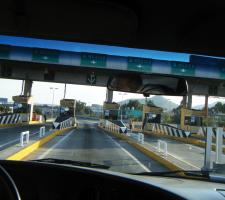
Mexico has embarked on an ambitious modernization program that includes both traditional road improvements and an emphasis on ITS (Picture courtesy of JOEM Promotions)
Promoting open market conditions for ITS deployment remains a major part of Mexico’s recent infrastructure modernization program. Travis P Dunn, partner at
One of the guiding strategies adopted by Mexico has been the promotion of open market conditions allowing for the competitive participation of various service providers in the ITS sector.
With over 111m residents, 35m automobiles and 350,000km of public roads, the challenge is sizeable.
The crowded capital region of Mexico City commands a large share of the nation’s population (22m) and vehicles (8m) as well as notorious congestion on the city’s streets and expressways. Passenger and freight traffic also jam the country’s extensive intercity highway network, however, which includes over 8000km of toll roads operated under concession agreements by over 40 public and private entities.
Despite decades of new infrastructure construction, congestion grows unabated and vehicle crashes claim over 20,000 lives annually. During the administration of President Felipe Calderón (2007- 2012), the Ministry of Communications and Transport, Secretaría de Comunicaciones y Transportes (SCT), launched a program dedicated to deploying advanced technologies to improve the performance of roadway operations. In particular, SCT has devoted resources to the development of national ITS standards, a national traffic information system and a nationwide electronic toll interoperability scheme.
Elements of ITS had already been deployed on various segments of Mexico’s roads, including variable message signs, a telephonebased traveler information system with limited coverage, and electronic toll collection. However, past ITS deployments were largely pursued independently without large-scale coordination across the many parties involved.
This is especially apparent in the area of electronic toll collection (ETC), where there are currently five distinct ETC service providers’ systems, with the possibility of many more coming on line in the near future. Some of these systems feature interoperable technology, but none have linked back-office systems that allow users to integrate accounts.
One of the principles that SCT has contemplated in its ITS deployment strategy is that of open systems – integrated systems based on common standards with interfaces and component specifications that are fully accessible to the marketplace.
The principal benefit of an open systems approach is choice. Choice for road operators means more competition, which leads to better quality, lower costs and greater flexibility as technology evolves. Choice for users of the road system means they can select from a range of providers to meet their needs — for example, for ETC, navigation, traveler information and safety systems. Choice for suppliers, meanwhile, means they can provide their products and services to a wider range of potential clients.
Drive for standards
Recognizing that standards provide a strong foundation for open systems and deployment of ITS, SCT has been pursuing the definition of a range of ITS standards. One of the overarching objectives in developing these standards is to ensure interoperability and interchangeability.One of the driving factors behind the effort to develop ITS standards in Mexico was the dispersed deployment of ITS equipment and services by a large number of organizations including distinct toll road operators, state governments and SCT itself. Early efforts focused on technical standards for such areas as:
- Variable message signs
- Air quality measurement station
- Inductive loop detectors
- Axle-count classification devices
- Weigh-in-motion systems
- CCTV cameras, signal transmission, recording and control
- License-plate recognition cameras
- Electronic toll collection equipment including tags, antennas and in-lane equipment
- Master control software for traffic management centers.
SCT has also been exploring the possibility of setting up an independent certification entity to test equipment for conformance with the standards before certifying it for use on Mexican roadways. SCT is still in the early stages of specifying a way forward on this issue.
Traveler information
In terms of traveler information, SCT is leading the development of a national system known as “Infoviaje”. This involves various activities, including data collection, data analysis, conversion into useful formats and distribution to users, either alone or alongside other services.SCT envisions performing all of these functions itself initially to ensure a basic level of service, but ultimately leaving the latter two to the marketplace in an open fashion. Any developer interested in providing traffic information services can access the data generated and shared by the various “sensors”, including equipment installed by road operators, SCT, third parties or users themselves (for example, via GPS-enabled smartphones).
ETC interoperability
The goal of electronic toll collection (ETC) interoperability in Mexico is a tall order, given the large number of road operators and other stakeholders involved. Customers, however, see interoperability as essential.Although ETC has existed in Mexico for almost two decades, its penetration is relatively modest, with just over a million customers compared to 10-20m in the US and Europe.
Rather than following the same maturation process as the US, which involved large procurements led by geographically fragmented road and toll facility operators, one possible alternative in Mexico is a market-based approach led by customers.
Allowing customers to ‘push’ the market rather than having road operators ‘pull’ it should mean the number of ETC options will expand, which will accelerate adoption rates, lower prices and improve quality, from the user’s perspective. Interoperability is, clearly, a prerequisite for this open systems approach.
There are currently five ETC service providers in Mexico - IAVE, E-Pass, QuickPass, Televía and ViaPass. To date, in-lane interoperability has been achieved by installing multi-protocol readers at some toll plazas.
However, there is not a single standard for tag technology in Mexico, and no user account interoperability exists for toll highways. The goal of “one tag, one account” remains elusive, therefore.
Several possible approaches for future integration have been identified, some of which conform with the open systems approach, and others which do not. They include:
- Pairwise agreements among ETC providers to achieve tag interoperability but not user account interoperability. This approach is basically an extension of what has already occurred, but would require additional agreements among toll service providers and installation of equipment at toll plazas. It would allow motorists to use a single tag at all participating toll facilities, while maintaining distinct accounts with each toll service provider. Although this represents an improvement over the current situation, it falls short of an open system and does not meet SCT’s objective, particularly for truck and bus fleets who stand to benefit the most from integrated tolling accounts.
- Pairwise agreements among ETC providers to achieve tag interoperability and a single user account. This approach does not necessarily represent an open system, as interoperability depends on the individual agreements and processes negotiated among the various service providers. Some may offer non-interoperable products, leaving customers unable to enjoy the benefits of a truly open system with real competition.
- Agreement among all ETC service providers to comply with a set of open standards designed to achieve interoperability of technology as well as integrated user accounts. This would create an open system in which customers could choose any service provider with confidence that it meets the standards set for national interoperability.
A number of difficult steps remain before Mexico can achieve true national interoperability, however. Not least, existing ETC service providers must agree to a framework that specifies ETC standards for tags, readers and other equipment, as well as procedures for funds netting, either through a clearing house or on a pairwise basis.
Efforts in the past year to achieve agreement on a framework have not yet resulted in a concrete way forward, however – partly due to market dynamics not lending themselves well to an open systems framework, partly due to the technologies in use, partly down to some inconsistency in SCT’s commitment to interoperability as a result of the change of administration following recent elections, among other things.
The future
Mexico remains in the early stages of putting intelligent transport systems on its federal highways, but steady commitment from SCT to policy guidance that is customer focused, alongside cooperation among the various road operators and a willingness by all parties to embrace open systems and competition could help achieve a level of ITS deployment and market dynamism on par with that seen in parts of Europe and the US.Customers, of course, are generally less concerned about the particular path taken to improve road services than they are about the speed of deployment and ultimate quality of services. An open systems approach would not only accelerate deployment, but give customers the ability to choose which combination of ITS products and services best suits them. This would make them an active participant in shaping the ITS market – more so than under traditional procurement models for ITS.
In this way, ITS can deliver the long-envisioned societal benefits of saving lives and saving money, while providing flexibility, choice and convenience to individuals.
This article is based on a paper given at the 19th ITS World Congress in Vienna in October 2012 by Travis P. Dunn and Steve Morello of D'Artagnan Consulting and Luis Lezama Elguero of the Secretaría de Comunicaciones y Transportes.













